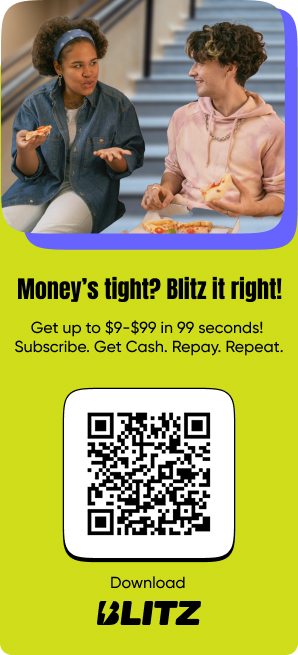Imagine this: you have rent, food, savings, and more to handle. It can get overwhelming fast. But what if there were a way to simplify things? Sounds good, right? With Kanban boards and checklists, you can manage your finances effectively.
With tools like Blitz, your money stops being a blur of numbers. Instead, it’s broken into steps you can actually see and manage. You are able to view where your money is being spent, what is arriving, and what really matters through visual budgeting.
Are you willing to get the money under your control? Let’s explore how visual tools can help you customize the budget that is right for you.
What Is Visual Budgeting?
Handling money can feel like juggling, especially in college. One can easily get lost in keeping track of what you spend, save, and when the due dates are. That’s where visual budgeting can help. Let’s know more about it.
Definition in Simple Terms
Visual budgeting is a way to plan your finances using Kanban boards or checklists instead of relying only on spreadsheets. It breaks your budget into easy steps.
Instead of writing your budget down, you use Kanban boards to group categories like “Rent” and “Groceries.” You track your progress by moving tasks between categories as you finish them.
This visual system makes dealing with money more interactive and straightforward.
Why It Appeals to Students
Students in college are mostly faced with tight budgets and busy timetables. That’s why visual budgeting becomes so important. While the traditional way of budgeting might put them in a dilemma of being too complicated.
Visual budgeting makes money manageable, and it doesn’t feel so much like work anymore, but more like a game you play and can win.
Kanban Boards for Money Management
Kanban boards make it easier for you to visually manage money. They are simple to configure and adjustable. You can engage with your finances interactively. Let’s explore how you can use Kanban for budgeting:
How Kanban Works
A Kanban board has columns for various tasks or expenses. One task is reflected in a card that you can move around. The columns may have:
- Income: It is a list of all the money that you receive, such as allowances or money from a part-time job.
- Bills: Include rent, heating, water, gas, and subscription costs.
- Savings: Such money that student keep for their faraway goals like an emergency.
- Goals: These may be something like a trip or new tech that you want to save for.
Setting Up a Financial Kanban Board
Creating a financial Kanban board is easy. Use paper or a tool such as Blitz. Make columns for important financial areas:
- To Pay: Expenses you need to pay, like rent or bills.
- Paid: Expenses that are already paid, so you know what has been handled.
- Saving: Cards that show savings goals or money you’re setting aside for emergencies or plans.
- Goals: Cards for any bigger money goals you might have, such as saving for a trip or a new computer.
This keeps you organized and gives you a good visual sense of your finances at a glance.
Benefits for Students
Kanban boards have numerous advantages for college students dealing with finances.
- You will see where your money goes, making it easier to stay on track.
- Strengthens your feeling of taking responsibility.
- Every time you transfer a card from “To Pay” to “Paid” or “Savings,” you feel the reward, and you get the motivation.
By using a Kanban board, it becomes much easier to keep an eye on the expenses and the goals that you have.
Checklists as a Budgeting Tool
Checklists are an easy and efficient method to keep your budget under control. You may be tracking everyday expenses or planning to save for the future, but checklists provide you with a clear picture of what to do and when to do it. Let’s learn more about it:
Why Checklists Work for Money
One of the reasons why checklists work is that they split major financial duties into small, manageable steps. Rather than handling a long list of expenses and savings goals, you focus on one job at a time. This method makes it easy to track the money spent, and it also stops one from feeling overwhelmed.
- Break down work into small parts so that nothing is overlooked.
- By keeping your financial goals manageable and visible, you provide a certain stability.
- Helps you focus on the next step without feeling swamped.
Using checklists simplifies money management. They help you stay organized with little effort.
Common Student Budgeting Checklists
Being a student, your financial tasks are usually short-term and repetitive. Simple checklists of this work may ease budgeting and reduce stress.
- Weekly grocery list with spending cap: This helps you control grocery costs and avoid impulse buys.
- Monthly bills checklist: Track rent, utilities, subscriptions, and other bills to ensure you pay on time.
- Savings habit checklist: Monitor savings goals, such as setting aside a specific amount each week or month.
These checklists tell you what needs to be done in order for you to keep your budget under control.
Combining Checklists With Digital Tools
It is great to have checklists on paper, but their use with digital tools can double their effectiveness. Apps like Blitz and tools such as Google Keep can make you more accountable and help you never miss a task.
- Reminders: Get reminded about the activities you need to do, such as payments or savings targets.
- Blitz tasks: Utilize Blitz to define and control checklists with tracking of progress.
- Google Keep: Sync devices for checklists and remain organized everywhere.
Digital tools enhance your checklists so you can keep your finances under control.
Read: 10 Best Budgeting Apps for College Students
Visual Budgeting in Practice – A Student Example
To help you visualize how to use Kanban boards and checklists for budgeting, let’s go through an example of a student’s visual budgeting system.
Step 1 – Income Column
Start by tracking your income. This could be from your part-time job, side gigs, or allowance. Add a card for each income source and note the amount and date.
Step 2 – Needs Column
Then, list your essential expenditures, such as rent, food, transport, and bills. Add a card for each expense. Move it to the “Paid” column once you have handled it.
Step 3 – Wants Column
After your needs, focus on your wants—like streaming services, dining out, and entertainment. Make a card for each want and shift it to the right column once paid.
Step 4 – Goals Column
Lastly, add savings goals to your board. If you’re saving for a trip or a new laptop, create a card with your target amount and date. As you save, move the card toward completion.
Benefits of Visual Budgeting vs. Traditional Budgeting
Visual budgeting poses definite benefits compared to conventional techniques such as spreadsheets or lists. Here’s why it excels and how it assists students with their finances.
Less Overwhelm, More Clarity
Traditional budgeting can be daunting with all its figures. Visual budgeting alleviates this by presenting tasks in a simple manner. Kanban boards allow students to quickly see progress and what needs attention.
Encourages Habit Formation
Visual budgeting makes every small task feel rewarding. Moving cards after paying bills or saving money builds positive habits. For students, this simple feedback makes finances easier and keeps motivation high.
Customizable & Flexible
Visual budgeting is flexible compared to strict conventional techniques. You can quickly modify your Kanban board or checklist for various needs, such as monitoring weekly expenditures or semester plans. This flexibility is ideal for the changing financial status of students.
Also read: DIY Decor for Dorm Rooms: Personalize Your Space on a Budget
How Blitz Supports Visual Budgeting
Blitz is an excellent option for students who wish to make budgeting easier. With features such as digital expense tracking, goal setting, and checklist integration, Blitz assists students in controlling their finances. Below is how it aids in visual budgeting:
Digital Expense Tracking With Categories
Blitz makes your financial goals very visible. It categorizes your spending and income, thus helping you locate the money that you have spent without any delay. This will keep your budget up to date and show your progress.
Goal-Setting With Progress Tracking
Blitz allows you to create financial goals and monitor them with visual bars. You can view how much closer you are to your savings goal, whether it is an emergency fund, a new phone, or a vacation.
Integration With Student Checklists
Blitz integrates budgeting and task management, allowing students to plan and organize spending. It is compatible with checklists, reminding you to look over finances and establish new goals as the semester progresses.
Quick Checklist – Start Visual Budgeting Today
Beginning visual budgeting is easy. Just follow these checklists:
- Create 3–4 columns: Create columns for “Income,” “Needs,” “Wants,” and “Goals” to categorize your budget.
- Add all expenses and savings: Write down your expenses and savings goals as cards or checklist items so you can easily follow along.
- Move items when paid/achieved: When you pay your bills or achieve your savings goals, move the cards to the right columns.
- Check progress weekly: Every week, assess the progress and, if necessary, make adjustments.
- Make use of Blitz as your tracking tool: Blitz is your tracking tool that makes everything easy and comfortable.
Conclusion – Make Budgeting Simple and Visual
Budgets can become manageable and transparent. With Blitz, the visual representation of your finances becomes possible. Along with Kanban boards and checklists, it allows you to easily monitor spending, savings, and manage your money.
No more juggling spreadsheets or wondering where your money went. Blitz makes budgeting simple and fun. Whether you’re a student or you have an irregular income, either way, visual budgeting will make it easier and more inspiring.
Ready to get in control of your money? Give Blitz a try and get budgeting on your side!
FAQs on Visual Budgeting
What’s the best app for Kanban-style budgeting?
Blitz is ideal for Kanban-style budgeting! It allows you to track spending and savings visually in columns and cards, making money management not so painful.
Can I use paper checklists instead of apps?
Absolutely! If paper is your thing, go ahead! Paper checklists are fine for budgeting if you keep them organized. However, it is quite convenient to have an app like Blitz for easy monitoring and updating.
How does visual budgeting compare to spreadsheets?
Visual budgeting is much more engaging and easier to use than spreadsheets. With Kanban boards or checklists, you will always have your progress at a glance.
What’s the easiest way to start if I’ve never budgeted before?
Just start with a simple approach! Create four categories like Income, Needs, Wants, and Goals. Thereafter, you may use Blitz or paper to check off your expenses as and when they occur.
How does Blitz help students with visual budgeting?
Blitz makes budgeting fun and easy! Along with Kanban boards and checklists, you are able to monitor expenses, set your goals, and track progress in real time. Whether for groceries, textbooks, or social events, Blitz helps you manage money stress-free.





